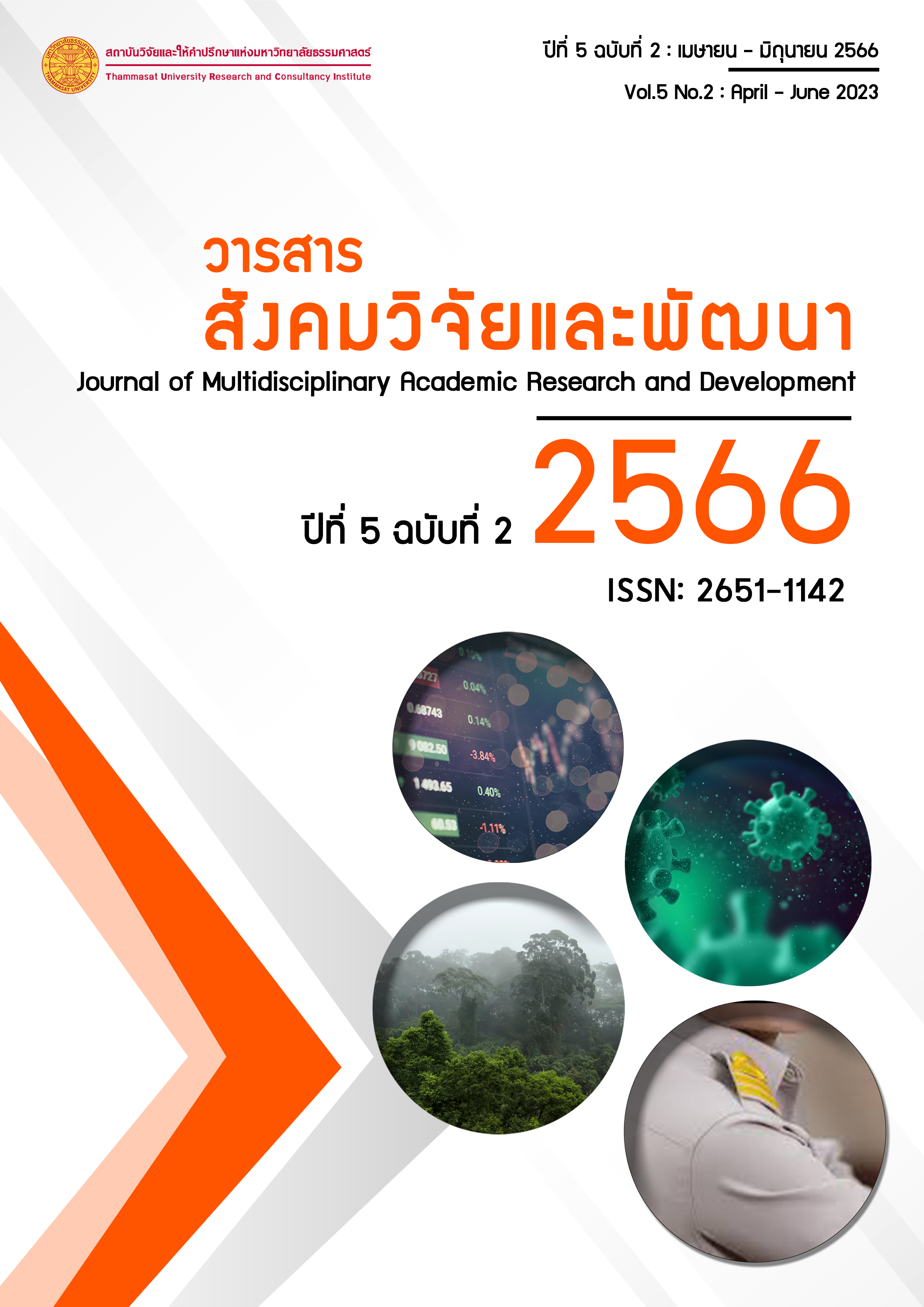The Effects of a Mindfulness at Work Program on Government Teachers and Education Personnel
Keywords:
Mindfulness at work, Program, Government teachers, Education personnelAbstract
This research 1) studied the meaning of mindfulness at work; 2) designed a program for developing mindfulness at work; and 3) compared mindfulness at work before and after personnel had attended a mindfulness development training program. Samples comprised 14 government teachers and educational personnel. Data was gathered from in-depth structured interviews; content analysis forms; government teacher and education personnel mindfulness at work program; and questionnaire and analyzed by mean, standard deviation and the Wilcoxon signed-rank test. Results were that 1) mindfulness at work means awareness and attention in the present moment without judging past events with awareness, caution, and care. Consciousness in accepting one's own behavior included thoughts, emotions, and feelings in three aspects: intent or teacher commitment and dedication to the task, concentrating on the goal of project success, while attention means interest, self-regulation, exploration, and development for effective productivity. Attitude means teacher thoughts, beliefs, feelings, and reactions to positive and negative feedback from people, things, and workplace situations; 2) work program for mindfulness for government teachers and education personnel consisted of eight development programs with 15 activities; and 3) government teachers and education personnel after joining mindfulness at work training programs rated higher than before at a statistical significance at .01.
References
เครือวัลย์ เผ่าผึ้ง. (2548). การพัฒนาคู่มือการจัดกิจกรรมส่งเสริมการอ่าน คิด วิเคราะห์ และเขียนสื่อความสำหรับครูภาษาไทย. (วิทยานิพนธ์ศึกษาศาสตรมหาบัณฑิต สาขาวิชาหลักสูตรและการนิเทศ, มหาวิทยาลัยศิลปากร).
คำพอง สมศรีสุข. (2545). การพัฒนาชีวิตตามหลักพุทธธรรม ศึกษากรณีการเจริญสติแบบเคลื่อนไหวของหลวงพ่อเทียน จิตตสุโก. (วิทยานิพนธ์ศิลปศาสตรมหาบัณฑิต สาขาไทยศึกษาเพื่อการพัฒนา, มหาวิทยาลัยราชภัฏเลย).
ฉัตรศิริ ปิยะมลสิทธิ์. (2548). ความเที่ยงตรง. เอกสารประกอบการสอนเรื่อง ทฤษฎีการวัดและการทดสอบ. คณะศึกษาศาสตร์ มหาวิทยาลัยทักษิณ.
ดวงพร ธรรมะ. (2558). การพัฒนาชุดฝึกอบรมด้วยตนเอง เรื่อง การมีสติ (Mindfulness). (วิทยานิพนธ์ ศึกษาศาสตรมหาบัณฑิต สาขาเทคโนโลยีการฝึกอบรม, มหาวิทยาลัยบูรพา).
ทิพย์สิริ กาญจนวาสี และศิริชัย กาญจนวาสี. (2559). วิธีวิทยาการวิจัย. พิมพ์ครั้งที่ 1. กรุงเทพมหานคร: จุฬาลงกรณ์มหาวิทยาลัย.
พิมพันธ์ เดชะคุปต์ และพเยาว์ ยินดีสุข. (2558). การจัดการเรียนรู้แนวในทศวรรษที่ 21. กรุงเทพมหานคร: จุฬาลงกรณ์มหาวิทยาลัย.
พุทธทาสภิกขุ. (2556). พุทธวิธีชนะความทุกข์. (พิมพ์ครั้งที่ 2). กรุงเทพฯ: ตถาตา.
วลัยลักษณ์ พิริยะสุรวงศ์. (2542). กระบวนการเรียนรู้แนวพุทธ ชีวิตไม่แยกจากการศึกษา. เอกสารประกอบการสอนเรื่องกระบวนการเสริมสร้างการเรียนรู้. มหาวิทยาลัยราชภัฏบุรีรัมย์.
Brown, K.W., & Ryan, R.M. (2003). The benefits of being present: Mindfulness and its role in psychological well-being. Journal of Personality and Social Psychology. 84(4), 822-848.
Brown, K.W., & Ryan, R.M. (2004). Perils and promise in defining and measuring mindfulness: Observations from experience. Clinical Psychology: Science & Practice. 11(3), 242-248.
Brown, V., & Olson, K. (2015). The Mindful School Leader: Practices to Transform Your Leadership and School. Corwin A SAGE Company, Thousand Oaks California 91320.
Bryk, A.S., & Schneider, B. (2004). Trust in Schools: A Core Resource for Improvement. New York: Russell Sage Foundation.
Capes, M. (2015). Determining the Best Training Classroom Size. Retrieved February 10, 2023, from https://www.td.org/insights/determining-the-best-sales-training-classroom-size.
Cronbach, L. J. (1949). Essentials of psychological testing. Harper.
Forsythe, P.B., Adams, C.M., & Hoy, W.K. (2011). Collective Trust: Why School Can’t Improve Without It. New York: Teacher College Press.
Iacobucci, D. & Duhachek, A. (2003). Advancing Alpha: Measuring Reliability With Confidence. Journal of Consumer. 13(4), 478-487.
Kabat-Zinn, J. (1994). Wherever you go, there you are: Mindfulness meditation in everyday life.New York: Hyperion.
Shapiro, S.L., & Carlson, L.E. (2009). The art and science of mindfulness: Integrating mindfulness into psychology and the helping professions. Washington, DC: APA.
Weick, K.E., & Sutcliffe, K.M. (2001). Managing the Unexpected: Assuring High Performance in an Age of Complexity. San Francisco, CA: Jossey-Bass.
Downloads
Published
How to Cite
Issue
Section
License
Copyright (c) 2023 Waranyoo Ongsara

This work is licensed under a Creative Commons Attribution-NonCommercial-NoDerivatives 4.0 International License.



